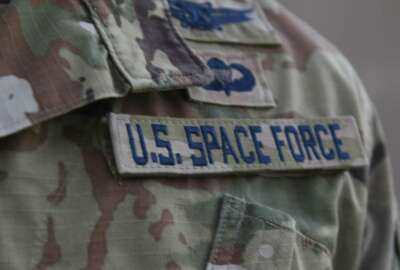Space Force taking action to become military’s first digital service
The service released a strategy in May to lay out how it would reach that goal, and now it’s putting some of it into practice.
The Space Force is touting itself as the first digital service. It released a strategy in May to lay out how it would reach that goal, and now it’s putting some of it into practice.
The newest military branch is undertaking a handful of pilots, training its guardians differently, using new technologies to manage internal affairs and curating the way it partners with sister services — all in hopes of entrenching that digital mindset.
“As the only U.S. military service to be established during the Information Age, the Space Force has the unique opportunity to be ‘born digital,’” Chief of Space Operations Gen. Jay Raymond wrote in the service’s Vision for a Digital Service strategy. “We will seize this opportunity. Space is a warfighting domain, and the threats we face cover great distances at tremendous speeds. We must embrace the Information Age tools at our disposal to ensure the domain is secure, stable, and accessible for our generation and the next. The Space Force will become the world’s first fully digital service. We will be an interconnected, innovative, digitally dominant force.”
The branch is undertaking multiple pilots to that end. Those pilots are using artificial intelligence and other processes to assess force readiness and to make better planning and programing decisions, according to Reb Butler III, who is part of the Space Force’s chief technology and innovation office.
“For example, we are applying some artificial intelligence techniques to speed up our hiring process,” he said during a Wednesday AFCEA event. “We’re using natural language processing to review, sort and prioritize thousands of applications and resumes. We’re doing that in hours versus weeks.”
The service is also setting up combat development teams in each of its deltas — the Space Force equivalent to an Air Force wing — to focus on innovation at the unit level and solve immediate operational challenges. The hope is to spur change from the bottom up, rather than waiting for it to come from the leadership down.
The Space Force is creating a digital environment to host industry as well to help foster innovation.
“We’re going to try to do a pilot later this year where we establish something like a model-based systems engineering environment with industry,” said Michael Dickey, director of the Force Design Integration Office.
The environment would help government and industry better understand requirements from a performance and resilience perspective.
“Through the lifecycle of a program, those models grow and become more mature and allow us to make later-on decisions, testing and evaluation much quicker,” Dickey said.
Training guardians to be digitally savvy is one of the top priorities of the digital service.
“Every airman today that is supporting the Space Force has a license to access a set of courses where it covers things like cybersecurity, digital product management and modern AI and machine learning,” said Army Brig. Gen. Rob Parker, deputy director of the Joint Staff J-6. “More than 30% of the fore has completed that initial set of coursework. We have established that our initial digital engineering system at the unclassified level and we have pathfinder programs within satellite communications that will use this educational environment to collaborate with partners.”
The Space Force is being cognizant of how it is partnering with its other less-digital partner services as well.
Dickey noted that the National Guard pre-dates the United States, and the Air Force was set up during the Cold War. That past comes with a lot of foundational and bureaucratic baggage. The Space Force has the advantage of fresh start. The service is trying to get its workforce right and find the right people to manage data within the service, but also to share it with other services.
“We look internally to see how we can go faster and we look externally to figure out how we can feed the right data at the right time to help inform that people we work with in the joint force,” he said.
The service is working with the Joint Artificial Intelligence Center to provide U.S. Space Command and other combatant commands with key operational intelligence information in a matter of seconds as AI and space begin to converge.
The Space Force’s digital vision was released just over a month ago and gives the service a chance to hone in on how it will build itself up. The strategy focuses on being interconnected, innovative and digitally dominant.
It has four focus areas to do that by creating a digital workforce, providing digital operations, developing products through digital engineering and leading through digital headquarters and data-driven decisions.
Copyright © 2025 Federal News Network. All rights reserved. This website is not intended for users located within the European Economic Area.
Scott Maucione is a defense reporter for Federal News Network and reports on human capital, workforce and the Defense Department at-large.
Follow @smaucioneWFED






